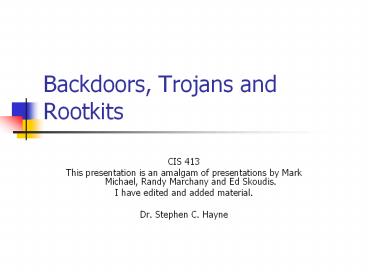Backdoors, Trojans and Rootkits - PowerPoint PPT Presentation
1 / 16
Title:
Backdoors, Trojans and Rootkits
Description:
Backdoors, Trojans and Rootkits CIS 413 This presentation is an amalgam of presentations by Mark Michael, Randy Marchany and Ed Skoudis. I have edited and added material. – PowerPoint PPT presentation
Number of Views:584
Avg rating:3.0/5.0
Title: Backdoors, Trojans and Rootkits
1
Backdoors, Trojans and Rootkits
- CIS 413
- This presentation is an amalgam of presentations
by Mark Michael, Randy Marchany and Ed Skoudis. - I have edited and added material.
- Dr. Stephen C. Hayne
2
- An alternative entryway
- No fancy authentication needed
- Maintains access on a system
- Usually access is needed initially
- Still works when front door is closed
3
- An attacker with back door access owns the
system - Attackers might make the system more secure to
keep ownership - The attacker does the work of the administrator
4
- Application-level Trojan Horse Backdoors
- Traditional RootKits
- Kernel-level RootKits
5
- Adds a separate application to the system
- Made up of a server and client part
- server is installed on victims machine
- client is installed on attackers machine
- Victim must install the server portion
- Once installed the attacker owns the victims
machine
6
- Most popular Windows backdoors
- Back Orifice 2000(BO2K)
- Sub7
- Hack-a-tack
- The Virtual Network Computer(VNC)
- remote administration tool often used as a
backdoor
7
- Back Orifice 2000
- Original Back Orifice released 1998
- Works on Windows 95/98/ME/NT/2000
- Open source
- Server portion is only 112KB
- Client portion is 568KB
- Product of the Cult of the Dead Cow (cDc)
8
(No Transcript)
9
- Log Keystrokes
- Gather system information
- Get passwords from the SAM database
- Control the file system
- Edit the registry
- Control applications and services
- Redirect Packets
10
- Application redirection
- Any DOS application can be spawned
- useful for setting up command-line backdoors
- Multimedia control
- View files in a browser
- Hidden mode
- Encryption between client and server
11
- Plug-ins
- Streaming video from server machine
- More encryption methods
- Blowfish, CAST-256, IDEA, Serpent, RC6
- Stronger security than a lot of commercial
products! - Stealthier methods for transport
12
- Most Anti-virus programs will notice and remove
the tools mentioned - Update virus definitions regularly
- Dont run programs downloaded from untrusted
sources - Dont auto-run ActiveX controls
13
Hidden Backdoors
SQL Server Hack!
Backdoor listens on port ABC
- Attacker takes over your system and installs a
backdoor to ensure future access - Backdoor listens, giving shell access
- How do you find a backdoor listener?
- Sometimes, they are discovered by noticing a
listening port - Nmap port scan across the network
- Running "netstat na" locally
- Running lsof (UNIX) or Inzider (Windows)
Network
14
Sniffing Backdoors
- Who says a backdoor has to wait listening on a
port? - Attackers don't want to get caught
- They are increasingly using stealthy backdoors
- A sniffer can gather the traffic, rather than
listening on an open port - Non-promiscuous sniffing backdoors
- Grab traffic just for one host
- Promiscuous sniffing backdoors
- Grab all traffic on the LAN
15
Non-Promiscuous Backdoor Cd00r
- Written by FX
- http//www.phenoelit.de/stuff/cd00r.c
- Includes a non-promiscuous sniffer
- Gathers only packets destined for the single
target machine - Several packets directed to specific ports (where
there is no listener) will trigger the backdoor - Sniffer grabs packets, not a listener on the
ports - Backdoor root shell starts to listen on TCP port
5002 only when packets arrive to the trigger ports
16
Non-Promiscuous Backdoor Cd00r in Action
Sniffer analyzes traffic destined just for this
machine, looking for ports X, Y, Z
Server
SYN to port X
SYN to port Y
SYN to port Z
After Z is received, activate temporary listener
on port 5002
Connection to root shell on port 5002
- The idea has been extended to eliminate even port
5002 - Netcat can push back a command shell from server,
so no listener ever required - Connection goes from server back to client
17
Promiscuous Backdoor
- Can be used to help throw off an investigation
- Attacker sends data for destination on same
network - But the backdoor isn't located at the destination
of the backdoor traffic - Huh? How does that work?
18
Promiscuous Backdoor in Action
Sniffer listens for traffic destined for WWW
server
Internet
- Backdoor is located on DNS server
- All packets sent to WWW server
- DNS server backdoor sniffs promiscuously
- In switched environment, attacker may use ARP
cache poisoning - Confusing for investigators
19
Sniffing Backdoor Defenses
- Prevent attacker from getting on system in the
first place (of course) - Know which processes are supposed to be running
on the system - Especially if they have root privileges!
- Not easy, but very important
- Beware of stealthy names (like "UPS" or "SCSI")
- Look for anomalous traffic
- Look for sniffers































